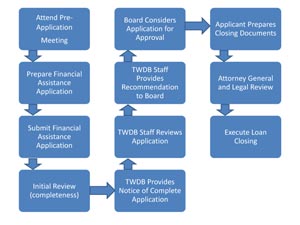Economically Distressed Areas Program (EDAP)
EDAP Program Information Sheet
General Program Information
1. What can the program do for you?
The Economically Distressed Areas Program (EDAP) provides financial assistance for projects serving economically distressed residential areas where water or sewer services do not exist, or existing systems do not meet minimum state standards.
2. Who can borrow?
Eligible EDAP applicants include cities, counties, water districts, nonprofit water supply corporations, and all other political subdivisions.
The program has several special requirements. The city or county where the project is located must adopt and enforce Model Subdivision Rules for the regulation of subdivisions prior to application for financial assistance. Projects must be located in an economically distressed area where the median household income is not greater than 75 percent of the median state household income. The residential subdivision must have existed on or before June 1, 2005. (See Special Requirements below for a more detailed listing.)
3. What types of projects can I use the loan funding for?
The program is specifically for first-time service where wells or on-site sewage systems are failing, or for existing water or wastewater systems that do not meet minimum state standards. In addition, only residential projects are eligible. EDAP assistance may be utilized for:
- planning;
- land acquisition;
- design, and
- construction of first-time service or improvements to water supply and wastewater collection and treatment works.
4. Does EDAP provide both grants and loans?
Yes. EDAP funding is provided in the form of a 70% grant and a 30% loan. The loan component is required to be made through the EDAP program. Loans are limited to a maximum of 20-year terms. A public health nuisance determination from the Texas Department of State Health Services is required for grant funding in an amount greater than 50 percent.
5. How does TWDB determine which projects receive funding?
Legislation passed in 2019 requires a formal prioritization criteria for projects in areas that address public health and safety and for projects in areas under enforcement actions. Please see the 2022 Intended Use Plan for ranking criteria and more information on the process.
6. How much funding is available?
Constitutional bonding authority is the primary mechanism for EDAP funding. In November 2019, Texas voters approved a proposition authorizing the TWDB to issue additional general obligation bonds in an amount not to exceed $200 million for EDAP projects. Individual bond issuances depend on biennial legislative appropriations. Appropriations were received to support the issuance of approximately $100 million in the current biennium.
7. What other changes have been made recently to EDAP?
Other significant changes include the following:
- Political subdivisions are required to show they are enforcing Model Subdivision Rules;
- Additional application requirements for proposed water quality enhancement projects;
- A formal prioritization system for EDAP applications;
- The total amount of grants may not exceed 70 percent of EDAP's total amount of financial assistance at any time;
- The TWDB is allowed to use EDAP bond proceeds to support public-private partnerships; and
- New program reporting requirements will be established.
SFY 2024-2025 EDAP Eligibilities Webinar
Special Requirements
EDAP financial assistance requires compliance with applicable rules, policies, and statutes including:
- Projects must be located in economically distressed areas with characteristics including:
- Median household income less than 75 percent of the median state household income.
- Present facilities are inadequate to meet residents' minimal needs.
- Financial resources are inadequate to provide water supply or sewer services to satisfy minimal needs.
- The area was an established residential subdivision as of June 1, 2005.
- The city or county where the project is located must adopt and enforce Model Subdivision Rules for regulating subdivisions prior to applying for financial assistance. These rules must be consistent with the model rules adopted by the TWDB.
- Texas Department of State Health Services nuisance determination for projects receiving over 50% grant.
- The applicant must apply for and maintain a designation by the Texas Commission on Environmental Quality as an authorized agent for regulating onsite waste disposal facilities.
- The county must prepare a map that shows where different types of on-site sewage disposal systems are appropriate.
- The applicant, or its designee, must be capable of maintaining and operating the completed system. The applicant is responsible for securing any necessary water permits or rights, wastewater discharge permits, and any other required licenses.
- If the applicant is required under Chapter 13 of the Water Code to have a Certificate of Convenience and Necessity (CCN) in order to provide service to the proposed project area then to be considered for EDAP funds, the applicant must have or be applying for the CCN.
- Water supply projects must be consistent with the current TWDB State Water Plan.
- Water Use Survey response for the previous three years must be on file for the applicant (31 TAC §358.5). Applicants that are wholesalers only are exempt from this requirement. Your survey response status is available here. To complete missing water use surveys, please visit the Water Use Survey webpage.
- Entities receiving assistance greater than $500,000 must adopt a water conservation and drought contingency plan.
- U.S. Iron and Steel Manufactured Goods requirements.
- Review of legislative requirements regarding water loss threshold limits.
Loan Process
Where Can I Get More Information?
In order to provide you with a single point of contact at the Texas Water Development Board (TWDB), our project implementation staff is organized into six regional project implementation teams. Each team is led by a manager that serves as the primary point of contact for both our existing and future customers. For assistance with the application or any questions related to your project, please contact your Regional Project Implementation Team.
